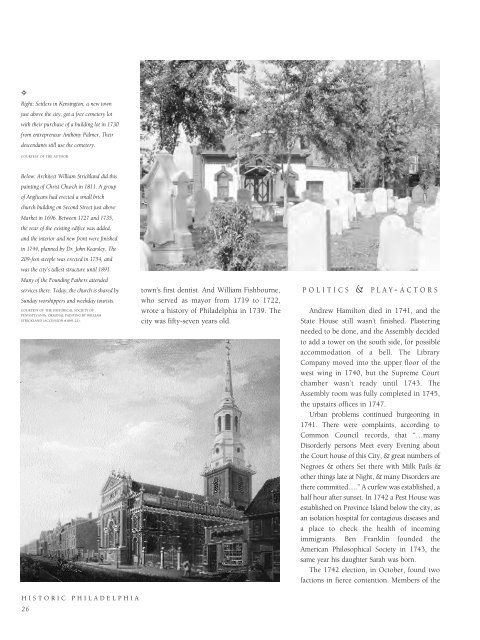Historic Philadelphia
An illustrated history of the city of Philadelphia, paired with the histories of companies, families and organizations that make the region great.
An illustrated history of the city of Philadelphia, paired with the histories of companies, families and organizations that make the region great.
Create successful ePaper yourself
Turn your PDF publications into a flip-book with our unique Google optimized e-Paper software.
✧<br />
Right: Settlers in Kensington, a new town<br />
just above the city, got a free cemetery lot<br />
with their purchase of a building lot in 1730<br />
from entrepreneur Anthony Palmer. Their<br />
descendants still use the cemetery.<br />
COURTESY OF THE AUTHOR.<br />
Below: Architect William Strickland did this<br />
painting of Christ Church in 1811. A group<br />
of Anglicans had erected a small brick<br />
church building on Second Street just above<br />
Market in 1696. Between 1727 and 1735,<br />
the rear of the existing edifice was added,<br />
and the interior and new front were finished<br />
in 1744, planned by Dr. John Kearsley. The<br />
209-foot steeple was erected in 1754, and<br />
was the city’s tallest structure until 1891.<br />
Many of the Founding Fathers attended<br />
services there. Today, the church is shared by<br />
Sunday worshippers and weekday tourists.<br />
COURTESY OF THE HISTORICAL SOCIETY OF<br />
PENNSYLVANIA. ORIGINAL PAINTING BY WILLIAM<br />
STRICKLAND (ACCESSION #1891.22).<br />
HISTORIC PHILADELPHIA<br />
26<br />
town’s first dentist. And William Fishbourne,<br />
who served as mayor from 1719 to 1722,<br />
wrote a history of <strong>Philadelphia</strong> in 1739. The<br />
city was fifty-seven years old.<br />
POLITICS<br />
& PLAY- ACTORS<br />
Andrew Hamilton died in 1741, and the<br />
State House still wasn’t finished. Plastering<br />
needed to be done, and the Assembly decided<br />
to add a tower on the south side, for possible<br />
accommodation of a bell. The Library<br />
Company moved into the upper floor of the<br />
west wing in 1740, but the Supreme Court<br />
chamber wasn’t ready until 1743. The<br />
Assembly room was fully completed in 1745,<br />
the upstairs offices in 1747.<br />
Urban problems continued burgeoning in<br />
1741. There were complaints, according to<br />
Common Council records, that “…many<br />
Disorderly persons Meet every Evening about<br />
the Court house of this City, & great numbers of<br />
Negroes & others Set there with Milk Pails &<br />
other things late at Night, & many Disorders are<br />
there committed….” A curfew was established, a<br />
half hour after sunset. In 1742 a Pest House was<br />
established on Province Island below the city, as<br />
an isolation hospital for contagious diseases and<br />
a place to check the health of incoming<br />
immigrants. Ben Franklin founded the<br />
American Philosophical Society in 1743, the<br />
same year his daughter Sarah was born.<br />
The 1742 election, in October, found two<br />
factions in fierce contention. Members of the
















